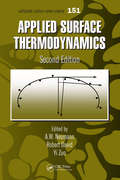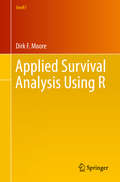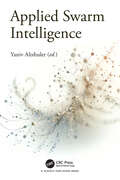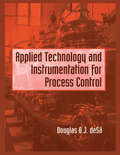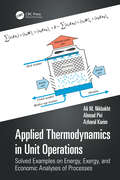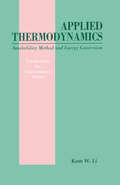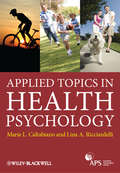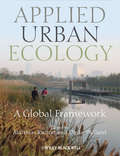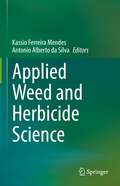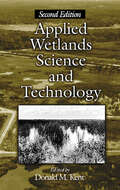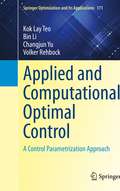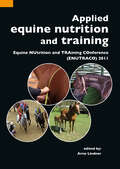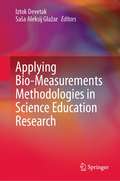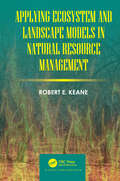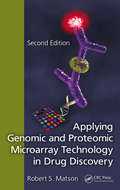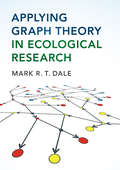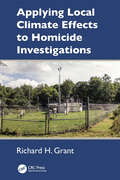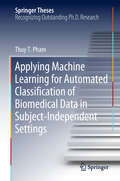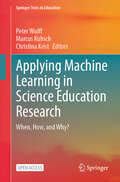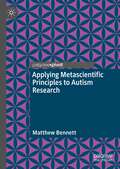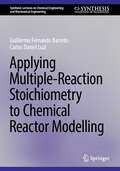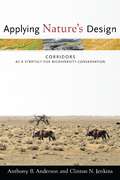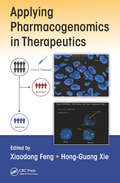- Table View
- List View
Applied Surface Thermodynamics (Surfactant Science)
by Robert David A. Wilhelm Neumann Yi ZuoSurface thermodynamics forms the foundation of any meaningful study of capillarity and wetting phenomena. The second edition of Applied Surface Thermodynamics offers a comprehensive state-of-the-art treatment of this critical topic. It provides students and researchers with fundamental knowledge and practical guidelines in solving real-world proble
Applied Survival Analysis Using R (Use R!)
by Dirk F. MooreApplied Survival Analysis Using R covers the main principles of survival analysis, gives examples of how it is applied, and teaches how to put those principles to use to analyze data using R as a vehicle. Survival data, where the primary outcome is time to a specific event, arise in many areas of biomedical research, including clinical trials, epidemiological studies, and studies of animals. Many survival methods are extensions of techniques used in linear regression and categorical data, while other aspects of this field are unique to survival data. This text employs numerous actual examples to illustrate survival curve estimation, comparison of survivals of different groups, proper accounting for censoring and truncation, model variable selection, and residual analysis. Because explaining survival analysis requires more advanced mathematics than many other statistical topics, this book is organized with basic concepts and most frequently used procedures covered in earlier chapters, with more advanced topics near the end and in the appendices. A background in basic linear regression and categorical data analysis, as well as a basic knowledge of calculus and the R system, will help the reader to fully appreciate the information presented. Examples are simple and straightforward while still illustrating key points, shedding light on the application of survival analysis in a way that is useful for graduate students, researchers, and practitioners in biostatistics.
Applied Swarm Intelligence
by Yaniv AltshulerThis book provides a comprehensive analysis of the tools and techniques used today for designing and modeling of efficient and robust swarm-intelligence based systems: highly (or fully) decentralized, semi-autonomous, highly-scalable infrastructures in various real-life scenarios. Among others, the book reviews the use of the swarm intelligence paradigm in financial investment, blockchain protocols design, shared transportation systems, communication networks, bioinformatics, and military applications. Theoretical and practical limitations of such systems, as well as trade-offs between the various economic and operational parameters of the systems, are discussed. The book is intended for researchers and engineers in the fields of swarm systems, economics, agriculture, nutrition, and operation research.
Applied Technology and Instrumentation for Process Control
by Douglas O. de SaApplied Technology and Instrumentation for Process Control presents the complex technologies of different manufacturing processes and the control instrumentation used. The large variety of processes prohibits covering more than a few. Carefully selected and diverse, but representative, examples show how fundamentally basic simpler elements or techn
Applied Thermodynamics for Meteorologists
by Miller SamThis textbook on atmospheric thermodynamics is for students of meteorology or atmospheric science. It also serves as a reference text for working professionals in meteorology and weather forecasting. It is unique because it provides complete, calculus-based derivations of basic physics from first principles, and connects mathematical relationships to real-world, practical weather forecasting applications. Worked examples and practice problems are included throughout.
Applied Thermodynamics in Unit Operations: Solved Examples on Energy, Exergy, and Economic Analyses of Processes
by Azharul Karim Ali M. Nikbakht Ahmad PiriThe growing demand of energy accounting in industries is the main challenge for academics and engineers working in chemical processing plants, food industries, and the energy sector. Applied Thermodynamics in Unit Operations addresses this demand and offers a clear contribution to the quantification of energy consumption in processes, while also solving the economic aspects of energy that are vital in real-life industrial contexts. Features• Combines the energy and exergy routines to analyze utilities and unit operations in a wide range of engineering scopes: nozzles, turbines, compressors, evaporators, HVAC, drying technology, steam handling, and power generation. • Offers a detailed procedure of finding economic wealth of energy in the operations. • Discusses basic concepts of thermal engineering and industrial operational insights through practiced examples, schematic illustrations, and software codes. • The only book to include practical problems of industrial operations solved in detail and complementary EES codes for the solutions. • Features examples selected from authors’ real-world experience in industrial projects. The book is a handy reference for researchers and practitioners in the areas of process, chemical, and mechanical engineering, undergraduate and postgraduate students in those disciplines, and engineers working in industry and production managers. Some examples are solved in EES to help the audience apply computer coding for thermal calculations.
Applied Thermodynamics: Availability Method And Energy Conversion (Combustion: An International Series #5)
by KamW. LiDeals with the availability method and its application to power plant system design and energy conversion. The first part of the book describes the development and the formulation of the availability method. The second part presents its applications to energy conversion processes. Examples for each energy conversion system are introduced and there are practice problems throughout the text.
Applied Topics in Health Psychology
by Lina Ricciardelli Marie Louise CaltabianoThis selection of in-depth, critical and comprehensive chapters on topical issues in applied health psychology features the work of key researchers and practitioners in the Australasian health system and deals with both theoretical and methodological aspects of the subject.The first health psychology text aimed specifically at regional postgraduate traineesCovers an array of topics and issues and focuses on applied aspects of clinical health and health promotionIncludes both specialized topics and new frontiers of researchContextualizes health psychology teaching and learning for Australasian students
Applied Tree Biology
by Peter A. Thomas Andrew HironsMany arborists learn tree work practices without fully understanding the biological and physiological principles behind them. However, outcomes for the health and longevity of trees are greatly improved when an arborist understands the science behind the care of tree root systems and crowns. In Applied Tree Biology, Drs. Hirons and Thomas draw upon their decades of experience in the laboratory, classroom, and the field – as well as the expertise of distinguished contributors to this volume – to provide those responsible for tree care with the scientific information that informs best practices for planting, pruning, soil decompaction, irrigation, and much more. Takes a multidisciplinary approach, integrating knowledge from plant biology, physiology, arboriculture, ecology, and more Provides a systematic presentation of fundamental tree biology and the scientific principles informing high quality tree care Presents accessible scientific information and best practices that help promote the health and longevity of trees Reflects the authors’ decades of experience as tree biology researchers and educators, as well as their years of professional experience across the globe Applied Tree Biology is an indispensable source of practical, succinct information on tree biology, physiology, and ecology for professionals and interested amateurs involved with the care of trees. Arborists, foresters, and horticulturists at all stages of their careers will find this text particularly useful.
Applied Urban Ecology: A Global Framework
by Matthias Richter Ulrike WeilandApplied Urban Ecology: A Global Framework explores ways in which the environmental quality of urban areas can be improved starting with existing environmental conditions and their dynamics. Written by an internationally renowned selection of scientists and practitioners, the book covers a broad range of established and novel approaches to applied urban ecology. Approaches chosen for the book are placed in the context of issues such as climate change, green- and open-space development, flood-risk assessment, threats to urban biodiversity, and increasing environmental pollution (especially in the “megacities” of newly industrialized countries). All topics covered were chosen because they are socially and socio-politically relevant today. Further topics covered include sustainable energy and budget management, urban water resource management, urban land management, and urban landscape planning and design. Throughout the book, concepts and methods are illustrated using case studies from around the world. A closing synopsis draws conclusions on how the findings of urban ecological research can be used in strategic urban management in the future. Applied Urban Ecology: A Global Framework is an advanced textbook for students, researchers and experienced practitioners in urban ecology and urban environmental research, planning, and practice.
Applied Weed and Herbicide Science
by Kassio Ferreira Mendes Antonio Alberto da SilvaThis textbook explores aspects of biology and ecophysiology of weeds, weed competition and interference in crops, phytosociological survey, methods of control and weed integrated management. Herbicides are of great importance in weed management and are one of the most widely used pesticide groups for weed control across the globe. Offering a new direction for research that focuses on herbicide behavior in plants, hormesis, evolution of weed resistance to herbicides, and genetically modified crops resistant to herbicides, this book covers the recent research in applied weed and herbicide science.This book provides essential and updated information on various subjects regarding the advances in herbicide science; and it is intended for professors, undergraduate, and graduate students, rural producers and other professionals involved in the area of applied weed and herbicide science. Agriculturists, analytical chemists, and toxicologists will find this book rewarding.
Applied Wetlands Science and Technology
by Donald M. KentContinuing the tradition of excellence established by the first edition, the Second Edition of Applied Wetlands Science and Technology provides the fundamentals for delineating, identifying, and regulating wetlands. It covers functions and values, ecological assessments, and how to minimize negative impacts on wetlands. The book also presents essen
Applied and Computational Optimal Control: A Control Parametrization Approach (Springer Optimization and Its Applications #171)
by Bin Li Kok Lay Teo Changjun Yu Volker RehbockThe aim of this book is to furnish the reader with a rigorous and detailed exposition of the concept of control parametrization and time scaling transformation. It presents computational solution techniques for a special class of constrained optimal control problems as well as applications to some practical examples. The book may be considered an extension of the 1991 monograph A Unified Computational Approach Optimal Control Problems, by K.L. Teo, C.J. Goh, and K.H. Wong. This publication discusses the development of new theory and computational methods for solving various optimal control problems numerically and in a unified fashion. To keep the book accessible and uniform, it includes those results developed by the authors, their students, and their past and present collaborators. A brief review of methods that are not covered in this exposition, is also included. Knowledge gained from this book may inspire advancement of new techniques to solve complex problems that arise in the future. This book is intended as reference for researchers in mathematics, engineering, and other sciences, graduate students and practitioners who apply optimal control methods in their work. It may be appropriate reading material for a graduate level seminar or as a text for a course in optimal control.
Applied equine nutrition and training: Equine NUtrition and TRAining COnference (ENUTRACO) 2011
by Arno LindnerThis book contains specialised information on the nutrition and training of the horse. Practical hints can be drawn from studies showing how apes indicate to us plants which have medicinal properties that can then be applied to equine treatment and also have an effect in nutraceuticals. Overviews are given on the potential of total mixed rations for the future of horse feeding and the practical feeding of obese horses and ponies. Nutrition considerations are given to avoid medical conditions. Methods used for performance diagnosis and training guidance of human athletes are applied here to equine management. In addition, training techniques which reduce the risk of back injury in the horse are explored and a review of the riders interaction with the horse is provided. Practical nutritional information acquired through research is applied to all aspects of managing endurance racehorses. Finally, expanded abstracts of original research are provided in very diverse fields of nutrition and training of horses. All those concerned with training, riding and feeding in the equine industry will benefit from the contents.
Applying Bio-Measurements Methodologies in Science Education Research
by Iztok Devetak Saša Aleksij GlažarThis book illustrates the problems of using eye tracking technology and other bio-measurements in science education research. It examines the application of bio-measurements in researching cognitive processes, motivation for learning science concepts, and solving science problems. Most chapters of this book use the eye-tracking method, which enables following the focus of the students’ attention and drawing conclusions about the strategies they used to solve the problem. This book consists of a total of fifteen chapters. Authors from eight countries emphasise the same trends despite their cultural and educational differences. The book begins with general chapters describing cognitive processes and how these processes are measured using eye-tracking methods and other psychophysiology parameters and motivation. Finally, the book concludes the chapters presenting studies in specific scientific fields from chemistry, biology, physics and geology.
Applying Ecosystem and Landscape Models in Natural Resource Management
by Robert E. KeaneManaging today’s lands is becoming an increasingly difficult task. Complex ecological interactions across multiple spatiotemporal scales create diverse landscape responses to management actions that are often novel, counter-intuitive and unexpected. To make matters worse, exotic invasions, human land use, and global climate change complicate this complexity and make past observational ecological studies limited in application to the future. Natural resource professionals can no longer rely on empirical data to analyze alternative actions in a world that is rapidly changing with few historical analogs. New tools are needed to synthesize the high complexity in ecosystem dynamics into useful applications for land management. Some of the best new tools available for this task are ecological and landscape simulation models. However, many land management professionals and scientists have little expertise in simulation modeling, and the costs of training these people will probably be exorbitantly high because most ecosystem and landscape models are exceptionally complicated and difficult to understand and use for local applications. This book was written to provide natural resource professionals with the rudimentary knowledge needed to properly use ecological models and then to interpret their results. It is based on the lessons learned from a career spent modeling ecological systems. It is intended as a reference for novice modelers to learn how to correctly employ ecosystem landscape models in natural resource management applications and to understand subsequent modeling results.
Applying Genomic and Proteomic Microarray Technology in Drug Discovery
by Robert S. MatsonMicroarrays play an increasingly significant role in drug discovery. The commercial landscape has changed dramatically over the past few years and researchers have made great advancements with regard to construction and use. Now in its second edition, Applying Genomic and Proteomic Microarray Technology in Drug Discovery highlights, describes, and
Applying Graph Theory in Ecological Research
by Dale Mark R. T.Graph theory can be applied to ecological questions in many ways, and more insights can be gained by expanding the range of graph theoretical concepts applied to a specific system. But how do you know which methods might be used? And what do you do with the graph once it has been obtained? This book provides a broad introduction to the application of graph theory in different ecological systems, providing practical guidance for researchers in ecology and related fields. Readers are guided through the creation of an appropriate graph for the system being studied, including the application of spatial, spatio-temporal, and more abstract structural process graphs. Simple figures accompany the explanations to add clarity, and a broad range of ecological phenomena from many ecological systems are covered. This is the ideal book for graduate students and researchers looking to apply graph theoretical methods in their work.
Applying Local Climate Effects to Homicide Investigations
by Richard H. GrantApplying Local Climate Effects to Homicide Investigation presents the concepts behind using local climate and weather records to enhance understanding of criminal cases. While sources of such local climate and weather information varies by country and regions, weather conditions are typically measured at airports or grassy areas as part of a national, regional, or state-wide networks using many different instruments.The information derived from such instruments and weather reporting services and agencies can inform and impact investigations, especially in the case of natural death or homicide cases. The determination of post-mortem interval (PMI) in homicide cases is often based on entomological or anthropological evidence in combination with local climate estimations. Determining the local climate conditions typically requires knowledge of the environmental conditions where the body is found and the conditions where the measurement record was made. Most people recognize that cities are hotter than the surrounding countryside and that lake and coastal shorelines are cooler than fields: all of these comprise local climates. The local climate where a corpse is discovered usually differs from where temperature and humidity measurements are made. Consequently, many investigators and forensic pathologists do not realize the influence that such local temperatures and humidity can have on post-mortem interval determinations.The book focuses on local climate conditions associated with the determination of post-mortem interval (PMI) and gives concepts behind adjusting climate information for local climates at the corpse. In addition, the book will present guidelines for crime scene investigators and lawyers to determine whether or not expert consultation is needed, and whether or not on-site measurements are needed. Most importantly, this book presents tools (data sources and modeling approaches) to guide forensic climatologists conducting forensic climatology work. It offers a basic, working understanding of the influence of the local environment on the local climate for forensic entomologists, forensic anthropologists, crime scene investigators, and lawyers. Numerous case studies are included throughout to show approaches, illustration decision points, and provide an understanding of the various impacts of regional and micro-climates upon decedents and their remains.
Applying Machine Learning for Automated Classification of Biomedical Data in Subject-Independent Settings (Springer Theses)
by Thuy T. PhamThis book describes efforts to improve subject-independent automated classification techniques using a better feature extraction method and a more efficient model of classification. It evaluates three popular saliency criteria for feature selection, showing that they share common limitations, including time-consuming and subjective manual de-facto standard practice, and that existing automated efforts have been predominantly used for subject dependent setting. It then proposes a novel approach for anomaly detection, demonstrating its effectiveness and accuracy for automated classification of biomedical data, and arguing its applicability to a wider range of unsupervised machine learning applications in subject-independent settings.
Applying Machine Learning in Science Education Research: When, How, and Why? (Springer Texts in Education)
by Peter Wulff Marcus Kubsch Christina KristThis open access textbook offers science education researchers a hands-on guide for learning, critically examining, and integrating machine learning (ML) methods into their science education research projects. These methods power many artificial intelligence (AI)-based technologies and are widely adopted in science education research. ML can expand the methodological toolkit of science education researchers and provide novel opportunities to gain insights on science-related learning and teaching processes, however, applying ML poses novel challenges and is not suitable for every research context. The volume first introduces the theoretical underpinnings of ML methods and their connections to methodological commitments in science education research. It then presents exemplar case studies of ML uses in both formal and informal science education settings. These case studies include open-source data, executable programming code, and explanations of the methodological criteria and commitments guiding ML use in each case. The textbook concludes with a discussion of opportunities and potential future directions for ML in science education. This textbook is a valuable resource for science education lecturers, researchers, under-graduate, graduate and postgraduate students seeking new ways to apply ML in their work.
Applying Metascientific Principles to Autism Research
by Matthew BennettThis book presents several metascientific strategies and explains how they can be used to improve research about the autism spectrum. It begins with an introduction to the field of metascience and the benefits that it brings to academic disciplines and society. It then outlines recommendations that researchers can adopt so that they do not incorporate specious autism research from predatory publishers into their research activities. An introduction to reproducibility and strategies that can improve the reproducibility of autism research are then outlined. This is followed by chapters about improving the peer review process and reducing the prospect of questionable research practices from occurring. This book concludes with a chapter about strategies that researchers can use to improve the participation of autistics in research. Such knowledge will equip academics, regardless of their experience, with the skills and expertise they need to produce high-quality and inclusive research about the autism spectrum.
Applying Multiple-Reaction Stoichiometry to Chemical Reactor Modelling (Synthesis Lectures on Chemical Engineering and Biochemical Engineering)
by Guillermo Fernando Barreto Carlos Daniel LuziThis book delves into the realm of Chemical Reaction Engineering (CRE) by showcasing the practical application of multiple-reaction stoichiometry. The authors critically assess various approaches commonly taught in undergraduate CRE courses to establish the relationships between changes in chemical species. In doing so, they propose an innovative conceptual alternative that is specifically tailored for undergraduate lectures. The book carefully selects composition measures that effectively harness the power of stoichiometric relationships in elementary reacting systems and models, which are typically covered in these courses. Going beyond the basics, it also offers a profound discussion on the value of chemical stoichiometry for tackling more intricate reaction systems and detailed models. Moreover, the book presents a simplified procedure that minimizes the reliance on complex linear algebra techniques, making the book accessible to a wider range of readers.
Applying Nature's Design: Corridors as a Strategy for Biodiversity Conservation (Issues, Cases, and Methods in Biodiversity Conservation)
by Anthony Anderson Clinton JenkinsThe fragmenting of habitats is endangering animal populations and degrading or destroying many plant populations throughout the world. To address this problem, conservationists have increasingly turned to biological corridors, areas of land set aside to facilitate the movement of species and ecological processes. However, while hundreds of corridor initiatives are under way worldwide, there is little practical information to guide their design, location, and management. <P><P>Applying Nature's Design offers a comprehensive overview of current knowledge on corridors, their design, and their implementation. Anthony B. Anderson and Clinton N. Jenkins examine a variety of conceptual and practical issues associated with corridors and provide detailed case studies from around the world. Their work considers how to manage and govern corridors, how to build support among various interest groups for corridors, and the obstacles to implementation. In addition to assessing various environmental and ecological challenges, the authors are the first to consider the importance of socioeconomic and political issues in creating and maintaining corridors.
Applying Pharmacogenomics in Therapeutics
by Xiaodong Feng Hong-Guang XieRecent advances in high-throughput gene sequencing and other omics biotechnologies have served as a springboard for the field of pharmacogenomics. Pharmacogenomics is now generally accepted as the major determinant of variable drug safety, efficacy, and cost-effectiveness. Therefore, widespread use of pharmacogenomics for patient care has become a
